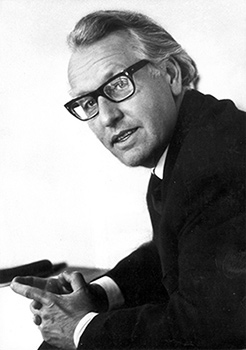Wieland Wagner facts for kids
Quick facts for kids
Wieland Wagner
|
|
|---|---|
 |
|
| Born | 5 January 1917 |
| Died | 17 October 1966 (aged 49) |
| Nationality | German |
| Occupation | Opera director |
| Known for | Member of Wagner family and Opera director |
| Children | Iris, Wolf-Siegfried, Nike and Daphne |
| Parent(s) | Siegfried Wagner and Winifred Wagner |
| Relatives | Richard Wagner, Friedelind Wagner, Wolfgang Wagner, Verena Wagner, Franz Liszt |
Wieland Wagner (born January 5, 1917 – died October 17, 1966) was a famous German opera director. He was the grandson of the well-known composer Richard Wagner. After World War II, Wieland helped reopen the Bayreuth Festival. He became known for his new and creative ways of staging operas. He moved away from old-fashioned, realistic sets. Instead, he used simple, symbolic designs and special lighting.
Contents
About Wieland Wagner's Life
Wieland Wagner was the older son of Siegfried Wagner and Winifred Wagner. His grandfather was the famous composer Richard Wagner. He was also the great-grandson of composer Franz Liszt.
In 1941, Wieland married Gertrud Reissinger, who was a dancer. They had four children: Iris, Wolf Siegfried, Nike, and Daphne.
Wieland received a special award called the Pour le Mérite in 1965. He passed away in October 1966 from lung cancer.
Wieland Wagner's Career in Opera
Wieland Wagner is seen as a pioneer of a new style in opera called Regietheater. This means he brought a modern approach to Wagner's operas. He changed how they were staged, using symbolic sets instead of realistic ones. His focus was on the characters' feelings and the story's deeper meaning.
Wieland started directing operas before World War II. He worked on operas by his father and grandfather. His truly new ideas became clear after the war ended.
Reopening the Bayreuth Festival
The Bayreuth Festival reopened in 1951 after the war. Wieland and his brother Wolfgang became the festival directors. Their mother, Winifred, had connections that made her unsuitable for the role.
Wieland's new productions were very different. Some people loved them, while others did not. His 1951 production of Parsifal showed many of his new ideas. Because of money limits after the war, he used simple, round sets. He also used special lighting from above, which was inspired by Adolphe Appia.
New Staging Ideas
Wieland's first post-war production of Siegfried featured a huge dragon statue. Later, he used giant eyes projected onto the stage to suggest a large creature.
In 1956, his production of Mastersingers was very symbolic. It did not show a real medieval town. Instead, it used a cobbled street shape and a ball that looked like a flowering tree.
Wieland's simple style also affected how singers acted. For example, in Götterdämmerung, a singer might lean forward to show a character's power. This was very different from traditional opera acting.
Work Beyond Bayreuth
Even though he is famous for his work at Bayreuth, Wieland also directed operas in other places. He worked in cities like Copenhagen, Naples, Stuttgart, Cologne, London, Paris, and Brussels. He directed operas like Tannhäuser, Der fliegende Holländer, the Ring, and Beethoven's Fidelio.
Wieland's wife, Gertrud, helped him a lot. She was trained in modern dance. She helped him create the movements for the singers and the chorus. She is credited for her work in many Bayreuth productions.
Collaborations with Singers and Conductors
Wieland worked closely with the German soprano Anja Silja. She was a very talented singer and actress. She performed many important roles for him, including Elsa in Lohengrin and Eva in Meistersinger. She also sang in operas like Elektra and Salome.
Many other famous singers worked with Wieland. These included Hans Hotter, George London, Dietrich Fischer-Dieskau, Wolfgang Windgassen, Birgit Nilsson, and Dame Gwyneth Jones. He wanted singers who were also great actors and could follow his artistic vision.
He also collaborated with many well-known conductors. Some of them were Hans Knappertsbusch, Herbert von Karajan, Pierre Boulez, and Karl Böhm.
Wieland Wagner's life and work are explored in the 2011 film The Wagner Family by Tony Palmer.
Wieland Wagner and World War II
Wieland Wagner's mother, Winifred Wagner, was a close friend of Adolf Hitler. Because of this, Wieland knew Hitler from a young age. In 1938, he joined the Nazi Party.
During the war, from 1944 to 1945, Wieland worked at a research institute in Bayreuth. This job helped him avoid being called to fight in the German army. At the institute, he built models for stage sets and worked on new stage lighting systems. He even had help from a prisoner, Hans Imhof, who was an electrical technician. After the war, in 1948, he was classified as a "follower" and given a small fine.
Videography
- Wagner: Tristan und Isolde (Nilsson, Windgassen, Töpper, Andersson, Hotter; Boulez, 1967) [live] Bayreuth Festival at Osaka International Festival
- Wagner: Die Walküre (Silja, Dernesch, G.Hoffman, Thomas, Adam, Nienstedt; Schippers, 1967) [live] Bayreuth Festival at Osaka International Festival
- Berg: Lulu (Silja, C.Alexander, Holm, Červená, Ferenz, Wildermann; Leitner, 1968) Stuttgart Staatsoper
Images for kids
See also
 In Spanish: Wieland Wagner para niños
In Spanish: Wieland Wagner para niños
- Wagner family tree


